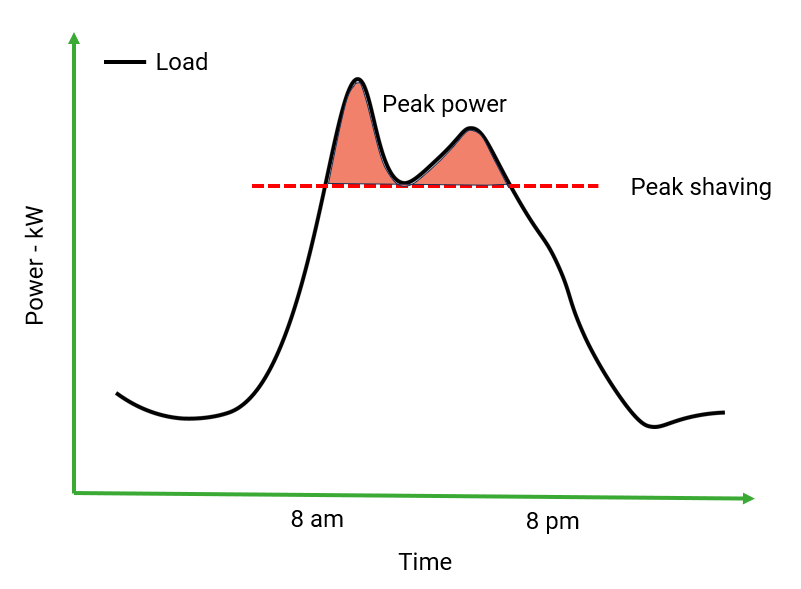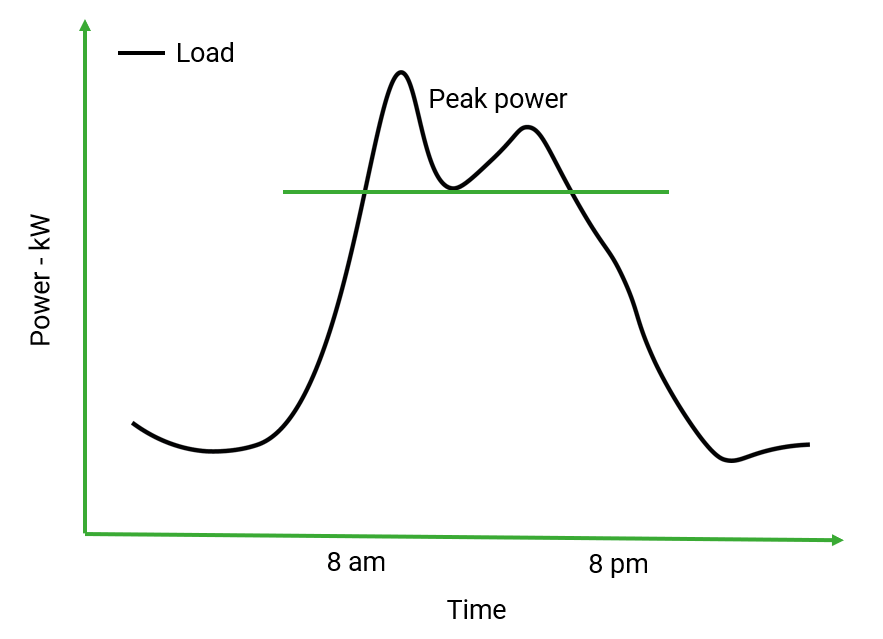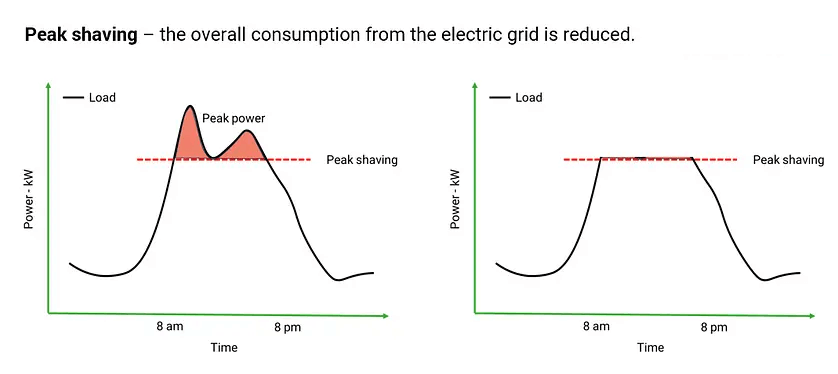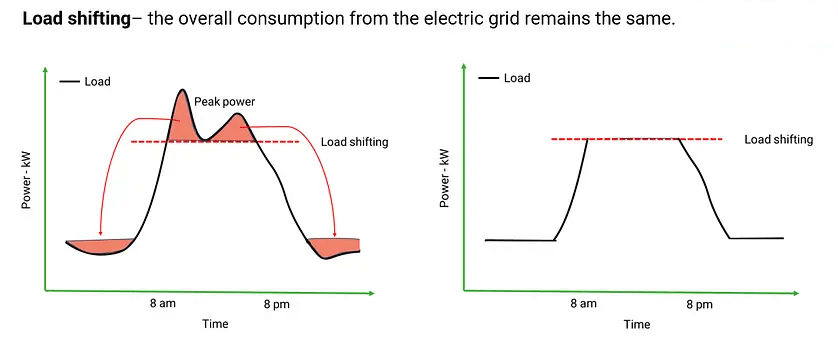At its core, peak shaving is employed to decrease the quantity of power consumed throughout periods of highest need, referred to as peak need periods. This strategy is essential for companies and industries that experience substantial changes in power usage throughout the day.
How Peak Shaving Works
Peak shaving works by recognizing these high-demand durations and tactically handling energy intake to decrease the top lots. This can be attained via various approaches, such as:
- Using backup generators
- Shifting non-essential energy use to off-peak times
- Implementing power storage solutions like batteries
The Value of Peak Shaving
The value of peak shaving cannot be overstated, as it directly affects operational costs and the electrical grid’s stability. By minimizing peak demand, businesses can:
- Avoid high demand charges imposed by utility companies
- Contribute to a more balanced and efficient energy distribution system
WHAT IS OPTIMAL SHAVING?


Peak shaving works by recognizing these high-demand durations and tactically handling energy intake to decrease the top lots. This can be attained via various approaches, such as using backup generators, moving non-essential energy use to off-peak times, or implementing power storage services like batteries.
it directly affects both operational prices and the security of the electrical grid. By minimizing peak need, services can prevent high need charges enforced by utility businesses and add to an extra well-balanced and efficient energy circulation system.
To offer a more precise understanding, below’s a table summing up the essential facets of optimal shaving:
| Aspect | Summary |
|---|---|
| Definition | Decrease of power consumption throughout peak need periods |
| Methods | Backup generators, lots moving, energy storage |
| Benefits | Reduced functional expenses, lowered need fees, boosted grid security |
| Applications | Commercial buildings, industrial facilities, data facilities |
Top shaving is a crucial technique for modern energy monitoring, using significant cost savings and adding to a more dependable power grid. By recognizing and implementing peak shaving strategies, services can better manage their power usage and optimize their functional efficiency.
Exactly How Does Peak Shaving Job?
Peak shaving is a tactical approach to managing and reducing electricity consumption during peak hours. The procedure involves identifying these peak hours and taking steps to minimize or shift the electrical load, thereby reducing the total demand on the grid. This not only helps reduce the cost of electricity but also makes the energy system more stable and efficient.
- Monitoring and controlling energy use: a common approach is using advanced metering facilities (AMIs), which provide real-time data on electricity use. This data is critical for determining peak duration and making informed decisions about efficiently handling load.
- Automated control systems: these can be configured to reduce or vary non-essential loads during peak hours. In this case, HVAC systems, lighting, and industrial programs can be readjusted or switched instantaneously to reduce total demand. In many more innovative configurations, these changes can respond immediately based on predetermined specifications or real-time data.
- Energy storage devices: By conserving energy during off-peak periods when electricity is more affordable and plentiful, these systems can release stored power during peak periods, minimizing the need to draw power from the grid. This helps save money and provides back-up power during grid instability.
- Demand combined with peak shaving: These programs typically incentivize customers to reduce or shift their electricity use during optimal use times through monetary rewards or lower energy rates. Customers can contribute to peak shaving efforts by participating in these programs while profiting from price economy savings.
Overall, the effectiveness of peak shaving depends on a combination of real-time data monitoring, automated control systems, electric storage solutions, and demand response programs. Utilizing these tools makes it possible to significantly reduce peak demand, resulting in lower energy prices and improved grid resiliency.
Comparison of Lots Shifting and Peak Shaving
| Facet | Load Shifting | Height Shaving |
|---|---|---|
| Objective | Change energy use to off-peak times | Minimize peak demand |
| Main Advantage | Lower energy prices | Lower demand costs |
| Implementation | Rescheduling tasks | Reducing or shutting off tons |
| Appropriate for | Flexible operations | High peak need situations |
When to Use Each Method
The option between tons moving and peak shaving depends upon the detailed needs and abilities of the center. Lots of moving is ideal for operations that can be quickly rescheduled without impacting efficiency. Conversely, peak shaving is extra matched for situations where the key objective is to avoid high demand costs by lowering peak lots.
For example, a business structure with considerable cooling lots could gain from peak shaving by minimizing air conditioning during height hours. On the other hand, a data facility with versatile computational jobs could select lots of moving to carry out energy-intensive operations during off-peak times.
Understanding the nuances of both strategies allows for a more customized power administration method, leading to substantial expense financial savings and enhanced functional effectiveness.
When To Use Peak Cutting Rather Than Lots Shifting


Understanding the optimal situations for utilizing peak shaving instead of fill changing is important for maximizing performance and cost savings. Both methods intend to manage electrical power usage, yet they satisfy different operational needs and situations.
Peak shaving is most effective when substantial, predictable spikes in power need to cause high peak demand charges. These charges, often one of the most pricey elements of an electricity bill, can be alleviated by reducing the peak tons throughout these durations. Peak shaving is advantageous for facilities with rising and fall power use patterns, such as manufacturing plants, information facilities, and commercial structures with heavy heating and cooling lots.
Load moving entails relocating power consumption from durations of high demand to periods of lower demand. This technique is excellent for centers that can schedule their energy-intensive processes throughout off-peak hours, capitalizing on reduced electrical energy prices. Tons moving is more appropriate for procedures with flexible routines, such as water treatment plants, cold storage centers, and specific industrial procedures.
When choosing in between peak shaving and lots shifting, think about the following factors:
- Predictability of Need: If your facility experiences normal, predictable optimals in power use, top shaving can efficiently minimize need charges. Tons changing may be better suited for more variable or less predictable usage patterns.
- Adaptability of Operations: Procedures that adjust their routines to prevent optimal periods will benefit significantly from lots of shifting. Alternatively, peak shaving is a much better option if your processes are much less adaptable and must go for specific times.
- Cost Structure: Analyze your electrical power toll structure. If peak demand charges make up a significant section of your costs, height shaving can yield substantial financial savings. On the other hand, if time-of-use prices are a lot more impactful, load changing may provide more significant advantages.
Inevitably, using peak shaving instead of tons moving should be based on a complete analysis of your center’s energy intake patterns, operational adaptability, and expense structure. By thoroughly examining these elements, you can apply one of the most effective strategies to optimize power use and decrease expenses.

FM Strategies
Peaking can be accomplished through various strategies, each with advantages and considerations. The following are the main approaches to peaking.
- Battery Energy Storage Systems (BESS): Batteries can store energy when grid demand is low and release it when demand is high. BESS is the most direct and flexible strategy to achieve peak shifting, responding quickly to changes in demand and supply and ensuring that critical loads operate during peak hours without stressing the grid. BESS is also beneficial when dealing with the inter-song nature of renewable energy, as it can store excess energy and release it later.
- On-site generation: If facilities have their generating capacity, such as natural gas generators, solar panels, or wind turbines, they can generate power during peak demand periods, reducing the need to draw power from the grid. On-site generation is often combined with energy storage for optimal results.
- Improving Energy Efficiency: By improving the energy efficiency of buildings and equipment, the overall electricity demand can be reduced, thus lowering peaks. Improving energy efficiency may involve upgrading to more energy-efficient lighting and equipment, improving insulation, or streamlining operations.
- Demand Response Programs: These programs incentivize energy users to minimize electricity use during peak hours, often in response to a signal from the utility. Energy users may receive monetary incentives or discounts on their electricity bills for participating. Several types of demand-side response programs exist in different parts of the world.
Peaking is best accomplished by selecting multiple strategies based on a customer’s specific energy needs, local grid infrastructure and availability, budget, and business goals. With advanced grid technologies, including IoT devices and smart meters, detailed data on energy use can help understand how energy is used and how peaking strategies can be implemented for the best results.
Battery storage for peak shaving
Battery storage space plays a vital function in the efficiency of peak shaving strategies. By keeping energy throughout periods of reduced demand and releasing it throughout peak times, battery systems help decrease the tons on the grid. This guarantees a more well-balanced energy circulation and causes considerable cost financial savings.
One of the key advantages of using battery storage space for peak shaving is its capability to respond rapidly to popular modifications. Unlike conventional approaches that count on reducing consumption or changing loads, battery storage space can give instant power, making it an optimal service for abrupt spikes in energy usage.
Here are some vital advantages of making use of battery storage space for peak shaving:
| Advantage | Description |
|---|---|
| Expense Savings | By minimizing peak need fees, companies can substantially reduce their electrical energy bills. |
| Improved Grid Stability | Batteries assist in preserving a secure grid by balancing supply and demand successfully. |
| Enhanced Energy Safety And Security | Battery storage space ensures a reliable power supply throughout height durations, lowering the danger of blackouts. |
| Environmental Benefits | By minimizing the demand for peaker plants, which are often much less effective and extra polluting, battery storage space adds to a lower carbon impact. |
Along with these benefits, the assimilation of battery storage with renewable resource sources such as solar and wind can better boost the performance of peak shaving. By saving excess eco-friendly energy produced throughout off-peak times and using it throughout height periods, organizations can minimize power costs and advertise clean power usage.
Furthermore, developments in battery innovation are making it significantly possible for businesses of all sizes to adopt battery storage space remedies. The lowering expense of batteries and their boosting capacity and efficiency make them a sensible alternative for many applications.
Peak shaving price financial savings
Among the most engaging advantages of carrying out peak shaving techniques is the capacity for substantial price savings. By lowering peak need, services can considerably reduce their electrical power costs, as energy businesses frequently bill more excellent rates throughout optimal usage. These charges are demand fees and can constitute a large portion of industrial or commercial electrical power costs.
To comprehend how peak shaving translates into cost financial savings, it’s vital to realize how need bills work. Energies calculate need fees based on the highest degree of power drawn throughout invoicing, normally measured in kilowatts (kW). By shaving these heights, services can decrease their maximum demand and, consequently, their demand costs.
Along with decreasing need costs, peak shaving can likewise aid in avoiding or reducing the requirement for extra infrastructure financial investments. By handling and lowering peak lots, businesses can postpone or also remove the demand for updating transformers, substations, and other electrical facilities, leading to further cost savings.
Also, peak shaving can enable companies to participate in demand feedback programs supplied by energies. These programs supply monetary motivations to reduce power usage throughout optimal periods. By tactically handling energy use and getting involved in such programs, businesses can earn added profits while contributing to grid security.
It’s likewise worth noting that the savings from peak shaving are not limited to large industrial entities. Business structures, information centers, and domestic complicated areas can gain from peak shaving approaches. Using modern technologies such as battery storage, clever thermostats, and power management systems, these entities can successfully minimize their peak need and attain purposeful cost savings.
Ultimately, the assimilation of renewable resource sources, such as solar and wind power, with peak shaving methods can even improve price savings. By producing and saving sustainable energy, services can reduce their reliance on grid power during peak periods, thus reducing their general energy prices.
Types of Loads Ideal for Height Shaving
Comprehending the types of tons suitable for peak shaving is critical to effectively executing this approach. Peak shaving entails decreasing the quantity of power eaten throughout peak demand periods, and specific sorts of tons are more amenable to this technique than others. Listed below, I will describe one of the most common sorts of lots that can be effectively taken care of for peak shaving.
1. A/c Equipments
Home heating, air flow, and A/c (cooling and heating) systems are typically the largest power customers in property and industrial settings. These systems are ideal for peak shaving because they can be cycled on and off without dramatically influencing convenience levels. Using sophisticated control systems, HVAC tons can be reduced throughout height periods and moved to off-peak times.
2. Industrial Equipment
Industrial equipment, such as compressors, pumps, and conveyor systems, can also be enhanced for peak shaving. These machines frequently have versatile operating timetables, permitting modifications in their use patterns. For example, non-essential equipment can be powered down or operated at reduced capability during optimal hours.
3. Lighting Equipments
Light systems can be substantial energy consumers, specifically in commercial and industrial settings. Implementing wise light controls, such as dimming or shutting off non-essential lights throughout peak times, can add to head-cutting efforts. Furthermore, utilizing energy-efficient LED lighting can additionally reduce the general lots.
4. Refrigeration Units
Refrigeration systems, including those used in supermarkets, stockrooms, and commercial facilities, can be tactically managed for peak shaving. These devices frequently have some thermal inertia, meaning they can keep their temperature level for a period also if the compressors are switched off. Pre-cooling during off-peak hours can lessen the tons during peak times.
5. Battery Storage Space Equipments
Battery storage space systems play a pivotal role in peak shaving by keeping power during off-peak hours and releasing it during peak need durations. This not only helps reduce the top lots but also enhances the total performance of the energy system. Batteries can be exceptionally reliable when combined with renewable power resources like solar or wind power.
| Kind of Lots | Suitability for Height Cutting | Instance Applications |
|---|---|---|
| HVAC Systems | High | Industrial buildings, Residential complexes |
| Industrial Machinery | Tool to High | Manufacturing facilities, Manufacturing plants |
| Lighting Equipment | Tool | Offices, Storehouses |
| Refrigeration Devices | Tool | Supermarkets, Freezer centers |
| Battery Storage Space Solutions | High | Residential solar setups, Grid storage space |
To conclude, the performance of top cutting mainly relies on identifying and managing the suitable types of lots. Substantial expense savings and performance enhancements can be attained by concentrating on HVAC systems, industrial equipment, lighting systems, refrigeration devices, and battery storage space systems. Understanding these lots types and their features is essential for optimizing the advantages of top shaving.





1 thought on “The Power of Peak Shaving: A Complete Guide”
Great write-up, I am normal visitor of one’s site, maintain up the excellent operate, and It’s going to be a regular visitor for a lengthy time.